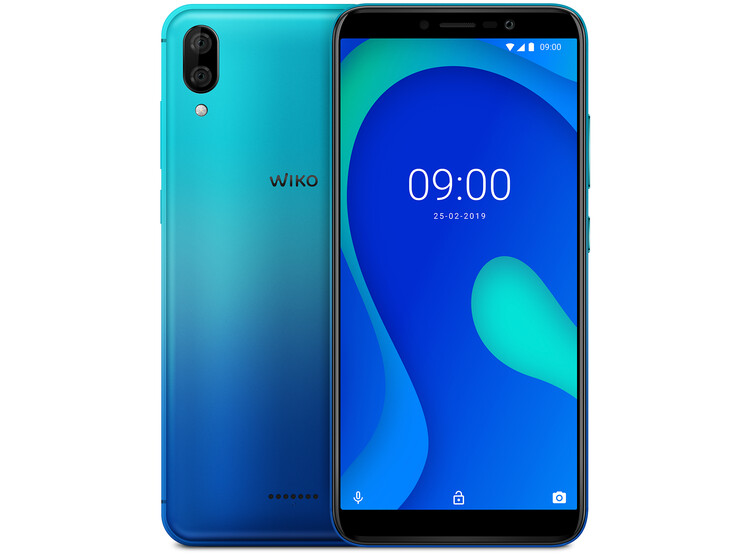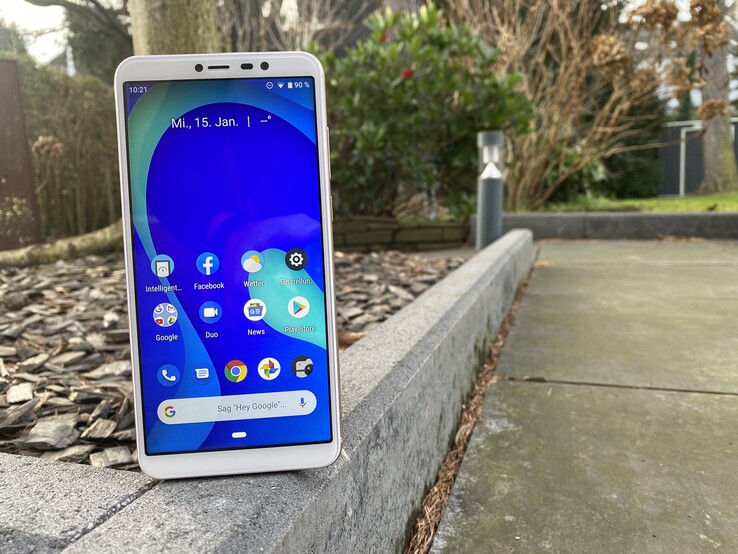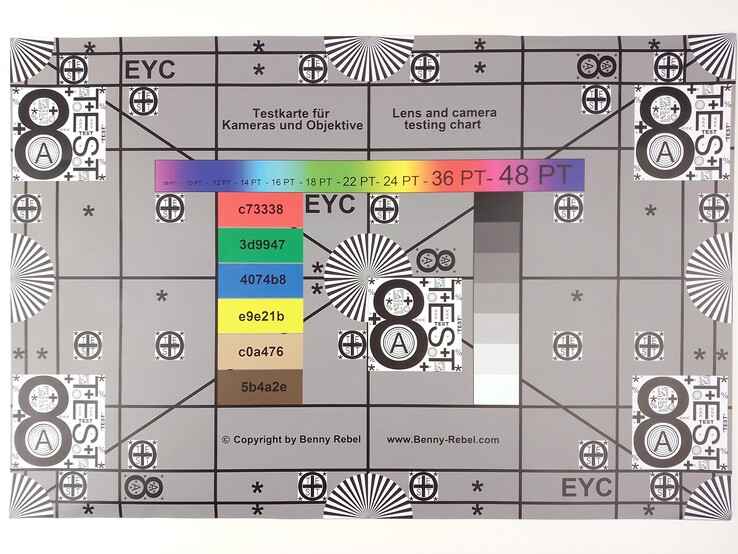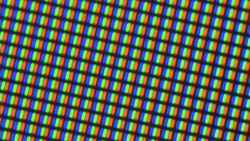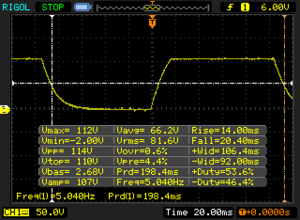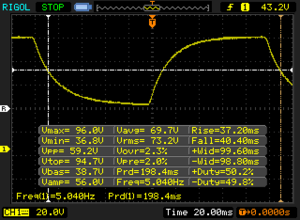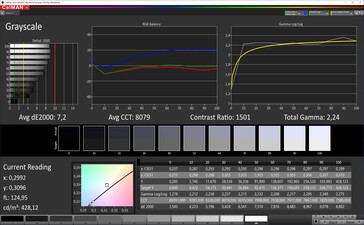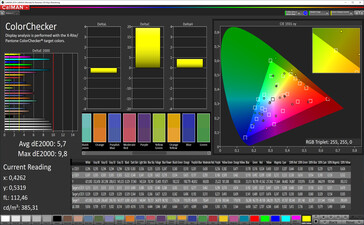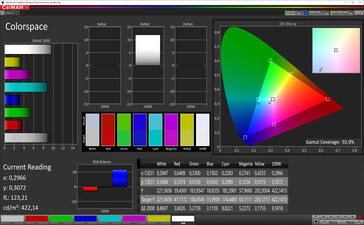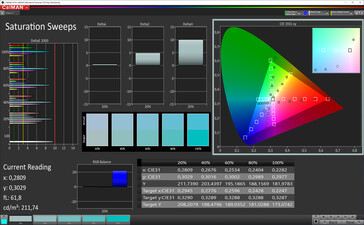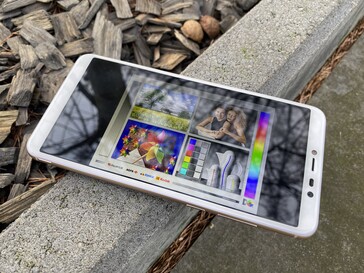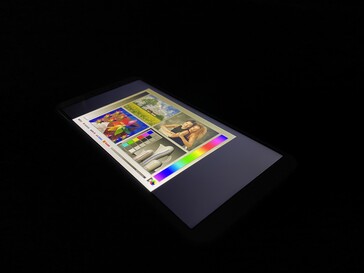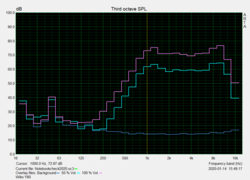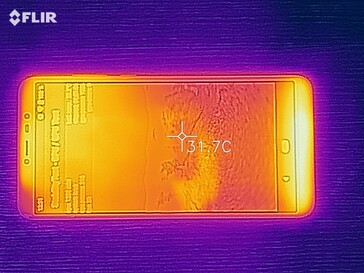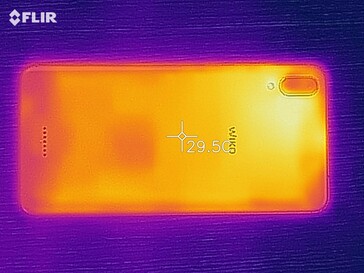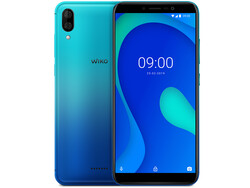Wiko Y80 Review - A lot of smartphone for under 100 Euro
Comparison devices
Bewertung | Rating Version | Datum | Modell | Gewicht | Laufwerk | Groesse | Aufloesung | Preis ab |
|---|---|---|---|---|---|---|---|---|
| 73.5 % v7 (old) | v7 (old) | 01 / 2020 | Wiko Y80 SC9863A, GE8322 / IMG8322 | 185 g | 16 GB eMMC Flash | 5.99" | 1440x720 | |
| 74.9 % v7 (old) | v7 (old) | 08 / 2019 | Samsung Galaxy A10 Exynos 7884B, Mali-G71 MP2 | 168 g | 32 GB eMMC Flash | 6.20" | 1520x720 | |
| 74.5 % v7 (old) | v7 (old) | 12 / 2019 | Xiaomi Redmi 8A SD 439, Adreno 505 | 188 g | 32 GB eMMC Flash | 6.22" | 1520x720 | |
| 72.8 % v7 (old) | v7 (old) | 06 / 2019 | Huawei Y5 2019 Helio A22 MT6761, PowerVR GE8300 | 146 g | 16 GB eMMC Flash | 5.71" | 1520x720 |
Case, equipment and operation
Wiko Y80 is available in three colours (blue, gold and bleen) and has a removable back. Nevertheless, the battery is firmly installed and is not intended to be changed by the user, which is why a thick foil has been stuck over it. There are also three slots under the plastic cover: one each for a micro-SIM, nano-SIM and microSD card. While the design looks a bit old-fashioned, the workmanship is on a good level, only the gap dimensions aren't always quite even on closer inspection.
For data exchange and charging the smartphone, a micro-USB port is available, which supports OTG. Beside the analog radio receiver there is also an audio jack integrated, furthermore the memory can be extended by a microSD card. There is no DRM certification, but this can be tolerated due to the low picture resolution.
Android 9.0 Pie is used as the operating system, over which the French put their in-house Wiko launcher. Wiko hasn't made any statements about a possible update to Android 10 so far, but we think this is unlikely.
In terms of communication modules, the entry-level mobile phone offers only the most necessary. The single-band WLAN isn't particularly fast, but delivers quite stable transfer rates in tests with our reference router, the Netgear Nighthawk AX12. The Y80 is well-equipped for mobile communications in terms of supported bands in the 2G and 3G range, but we miss band 28 for LTE. NFC must be omitted.
The touchscreen reacts quite quickly and reliably in the test, and the sliding properties of the glass surface aren't to be criticized either. There is no fingerprint sensor, instead Wiko relies on 2D face recognition, which works quite reliably, but is less secure.
| Networking | |
| iperf3 transmit AX12 | |
| Huawei Y5 2019 | |
| Xiaomi Redmi 8A | |
| Wiko Y80 | |
| Samsung Galaxy A10 | |
| iperf3 receive AX12 | |
| Huawei Y5 2019 | |
| Xiaomi Redmi 8A | |
| Samsung Galaxy A10 | |
| Wiko Y80 | |
Cameras - Wiko mobile with Dual-Cam
The front camera overdoes it when taking portraits and has a quite aggressive soft focus, which can also be deactivated. The pictures could use a bit more dynamic.
The dual camera on the back offers an additional lens for collecting depth information. In good lighting conditions, the pictures look a bit dark and quite cool. Moreover, the lens tends to be partially overexposed, but the sharpness is okay.
Videos are recorded at 1,080p (30 FPS) on both sides. The sound is accompanied by an audible noise and the autofocus often needs some time to adjust.
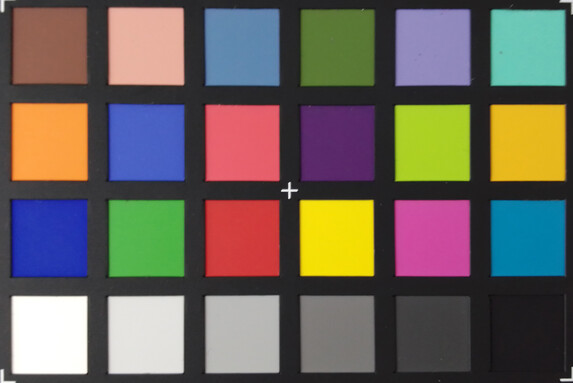
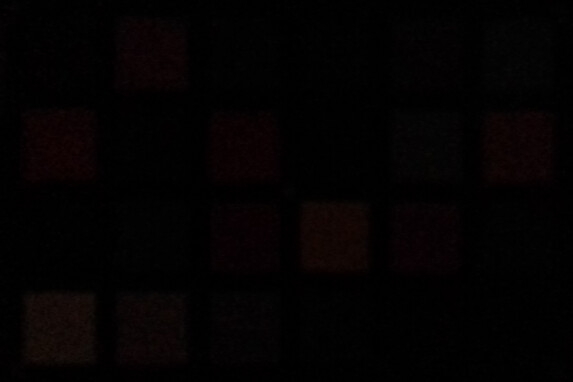
Display - Good panel in Wiko Y80
The almost six-inch IPS display of the Wiko Y80 only offers the small HD resolution, which is sufficiently high resolution, but individual pixels may well be visible. The brightness is on a good level and can be called up even when the ambient light sensor is deactivated and remains constant during the APL50 measurement.
It's also pleasing that we can't detect any flickering of the panel. The CalMAN analysis shows a visible blue cast, which is reflected in everyday life as a cool image display, but isn't disturbing.
| |||||||||||||||||||||||||
Brightness Distribution: 92 %
Center on Battery: 423 cd/m²
Contrast: 1567:1 (Black: 0.27 cd/m²)
ΔE ColorChecker Calman: 5.7 | ∀{0.5-29.43 Ø4.78}
ΔE Greyscale Calman: 7.2 | ∀{0.09-98 Ø5}
92.9% sRGB (Calman 2D)
Gamma: 2.24
CCT: 8079 K
| Wiko Y80 IPS, 1440x720, 6" | Samsung Galaxy A10 IPS, 1520x720, 6.2" | Xiaomi Redmi 8A IPS, 1520x720, 6.2" | Huawei Y5 2019 IPS, 1520x720, 5.7" | |
|---|---|---|---|---|
| Response Times | 52% | 26% | 60% | |
| Response Time Grey 50% / Grey 80% * (ms) | 77.6 ? | 38 ? 51% | 52 ? 33% | 30 ? 61% |
| Response Time Black / White * (ms) | 34.4 ? | 16 ? 53% | 28 ? 19% | 14 ? 59% |
| PWM Frequency (Hz) | 77 ? | 595 ? | 1000 ? | |
| Screen | 4% | 0% | -12% | |
| Brightness middle (cd/m²) | 423 | 451 7% | 441 4% | 630 49% |
| Brightness (cd/m²) | 417 | 430 3% | 421 1% | 593 42% |
| Brightness Distribution (%) | 92 | 90 -2% | 89 -3% | 88 -4% |
| Black Level * (cd/m²) | 0.27 | 0.22 19% | 0.38 -41% | 0.66 -144% |
| Contrast (:1) | 1567 | 2050 31% | 1161 -26% | 955 -39% |
| Colorchecker dE 2000 * | 5.7 | 5.44 5% | 4.46 22% | 5.79 -2% |
| Colorchecker dE 2000 max. * | 9.8 | 11.94 -22% | 8.01 18% | 9.54 3% |
| Greyscale dE 2000 * | 7.2 | 7.8 -8% | 5.4 25% | 7 3% |
| Gamma | 2.24 98% | 2.206 100% | 2.146 103% | 2.176 101% |
| CCT | 8079 80% | 9149 71% | 7901 82% | 8420 77% |
| Total Average (Program / Settings) | 28% /
14% | 13% /
5% | 24% /
3% |
* ... smaller is better
Display Response Times
| ↔ Response Time Black to White | ||
|---|---|---|
| 34.4 ms ... rise ↗ and fall ↘ combined | ↗ 14 ms rise | |
| ↘ 20.4 ms fall | ||
| The screen shows slow response rates in our tests and will be unsatisfactory for gamers. In comparison, all tested devices range from 0.1 (minimum) to 240 (maximum) ms. » 92 % of all devices are better. This means that the measured response time is worse than the average of all tested devices (20.2 ms). | ||
| ↔ Response Time 50% Grey to 80% Grey | ||
| 77.6 ms ... rise ↗ and fall ↘ combined | ↗ 37.2 ms rise | |
| ↘ 40.4 ms fall | ||
| The screen shows slow response rates in our tests and will be unsatisfactory for gamers. In comparison, all tested devices range from 0.165 (minimum) to 636 (maximum) ms. » 99 % of all devices are better. This means that the measured response time is worse than the average of all tested devices (31.6 ms). | ||
Screen Flickering / PWM (Pulse-Width Modulation)
| Screen flickering / PWM not detected | |||
In comparison: 53 % of all tested devices do not use PWM to dim the display. If PWM was detected, an average of 8111 (minimum: 5 - maximum: 343500) Hz was measured. | |||
Performance, emissions and battery life
The Wiko Y80 is driven by an exotic processor, which, however, succeeds in achieving a convincing system performance despite the lame memory. Demanding games are certainly not the smartphone's métier, but for small casual games it is enough.
The surface temperatures rise up to 34°C under constant load, but this is absolutely harmless.
The loudspeaker on the back of the Wiko phone is very high pitched and sounds a bit shrill, low tones almost completely disappear. The sound output via the audio jack is inconspicuous and low-noise, but is accompanied by an audible hum, and the basses are not very pronounced here either. Playback via Bluetooth (SBC and LDAC) works perfectly.
Despite the 4,000 mAh battery, the Y80 is the tail light in the comparison field. The runtimes are good, but should have been higher with such a strong energy storage.
| PCMark for Android | |
| Work performance score (sort by value) | |
| Samsung Galaxy A10 | |
| Xiaomi Redmi 8A | |
| Huawei Y5 2019 | |
| Average UNISOC SC9863A (6601 - 6861, n=3) | |
| Work 2.0 performance score (sort by value) | |
| Wiko Y80 | |
| Samsung Galaxy A10 | |
| Xiaomi Redmi 8A | |
| Huawei Y5 2019 | |
| Average UNISOC SC9863A (4389 - 4694, n=6) | |
| GFXBench | |
| on screen Aztec Ruins Normal Tier Onscreen (sort by value) | |
| Wiko Y80 | |
| Samsung Galaxy A10 | |
| Xiaomi Redmi 8A | |
| Huawei Y5 2019 | |
| Average UNISOC SC9863A (3 - 6.2, n=8) | |
| Average of class Smartphone (6.2 - 166, n=210, last 2 years) | |
| 1920x1080 Aztec Ruins Normal Tier Offscreen (sort by value) | |
| Wiko Y80 | |
| Samsung Galaxy A10 | |
| Xiaomi Redmi 8A | |
| Huawei Y5 2019 | |
| Average UNISOC SC9863A (3.2 - 3.4, n=8) | |
| Average of class Smartphone (3.4 - 367, n=210, last 2 years) | |
| on screen Aztec Ruins High Tier Onscreen (sort by value) | |
| Wiko Y80 | |
| Samsung Galaxy A10 | |
| Xiaomi Redmi 8A | |
| Huawei Y5 2019 | |
| Average UNISOC SC9863A (1.9 - 3.8, n=8) | |
| Average of class Smartphone (0.85 - 144, n=211, last 2 years) | |
| 2560x1440 Aztec Ruins High Tier Offscreen (sort by value) | |
| Wiko Y80 | |
| Samsung Galaxy A10 | |
| Xiaomi Redmi 8A | |
| Huawei Y5 2019 | |
| Average UNISOC SC9863A (1.1 - 1.2, n=7) | |
| Average of class Smartphone (1.2 - 129, n=210, last 2 years) | |
| Wiko Y80 | Samsung Galaxy A10 | Xiaomi Redmi 8A | Huawei Y5 2019 | Average 16 GB eMMC Flash | Average of class Smartphone | |
|---|---|---|---|---|---|---|
| AndroBench 3-5 | 115% | 120% | 85% | 5% | 2962% | |
| Sequential Read 256KB (MB/s) | 91.3 | 296.4 225% | 282 209% | 272.1 198% | 164.5 ? 80% | 2213 ? 2324% |
| Sequential Write 256KB (MB/s) | 65.1 | 101.7 56% | 106.4 63% | 45.2 -31% | 43 ? -34% | 1831 ? 2713% |
| Random Read 4KB (MB/s) | 19.06 | 73.4 285% | 73.1 284% | 62.1 226% | 21.7 ? 14% | 294 ? 1442% |
| Random Write 4KB (MB/s) | 6.09 | 13.3 118% | 15.8 159% | 13.1 115% | 8.08 ? 33% | 333 ? 5368% |
| Sequential Read 256KB SDCard (MB/s) | 80.6 ? | 78.8 ? -2% | 84.9 ? 5% | 81.8 ? 1% | 59.1 ? -27% | |
| Sequential Write 256KB SDCard (MB/s) | 61.6 ? | 65.3 ? 6% | 61.7 ? 0% | 63.1 ? 2% | 39.8 ? -35% |
Temperature
(+) The maximum temperature on the upper side is 34 °C / 93 F, compared to the average of 35.2 °C / 95 F, ranging from 21.9 to 247 °C for the class Smartphone.
(+) The bottom heats up to a maximum of 33 °C / 91 F, compared to the average of 34 °C / 93 F
(+) In idle usage, the average temperature for the upper side is 27.9 °C / 82 F, compared to the device average of 32.9 °C / 91 F.
Speakers
Wiko Y80 audio analysis
(+) | speakers can play relatively loud (83.6 dB)
Bass 100 - 315 Hz
(-) | nearly no bass - on average 41.2% lower than median
(+) | bass is linear (5.5% delta to prev. frequency)
Mids 400 - 2000 Hz
(±) | reduced mids - on average 8.5% lower than median
(±) | linearity of mids is average (10.1% delta to prev. frequency)
Highs 2 - 16 kHz
(+) | balanced highs - only 4.5% away from median
(+) | highs are linear (2.5% delta to prev. frequency)
Overall 100 - 16.000 Hz
(±) | linearity of overall sound is average (29.9% difference to median)
Compared to same class
» 78% of all tested devices in this class were better, 3% similar, 19% worse
» The best had a delta of 11%, average was 35%, worst was 134%
Compared to all devices tested
» 88% of all tested devices were better, 3% similar, 10% worse
» The best had a delta of 4%, average was 24%, worst was 134%
Samsung Galaxy A10 audio analysis
(+) | speakers can play relatively loud (86.1 dB)
Bass 100 - 315 Hz
(-) | nearly no bass - on average 75.4% lower than median
(+) | bass is linear (0% delta to prev. frequency)
Mids 400 - 2000 Hz
(-) | nearly no mids - on average 75.4% lower than median
(+) | mids are linear (0% delta to prev. frequency)
Highs 2 - 16 kHz
(-) | nearly no highs - on average 75.4% lower than median
(+) | highs are linear (0% delta to prev. frequency)
Overall 100 - 16.000 Hz
(-) | overall sound is not linear (123.3% difference to median)
Compared to same class
» 92% of all tested devices in this class were better, 7% similar, 1% worse
» The best had a delta of 11%, average was 35%, worst was 134%
Compared to all devices tested
» 98% of all tested devices were better, 2% similar, 0% worse
» The best had a delta of 4%, average was 24%, worst was 134%
Battery life
| Wiko Y80 4000 mAh | Samsung Galaxy A10 3400 mAh | Xiaomi Redmi 8A 5000 mAh | Huawei Y5 2019 3020 mAh | Average of class Smartphone | |
|---|---|---|---|---|---|
| Battery Runtime | |||||
| WiFi Websurfing (h) | 11.6 | 12.6 9% | 19.1 65% | 11.8 2% | 19.3 ? 66% |
Pros
Cons
Verdict - Cheap mobile phone for those willing to compromise
A smartphone for under 100 Euros often demands a lot of compromises from the user, which is certainly the case with the Wiko Y80, but the French find a quite successful middle way, which makes this smartphone a cheap alternative.
The look is probably a matter of taste and the workmanship is absolutely fine. Positive in any case is the fully-fledged dual-SIM solution and an optional memory expansion, including support for the exFAT file system. Especially the latter is by no means mandatory in this price range. The Wiko phone's memory is very slow in the test, but this is hardly noticeable in everyday use. If you use your mobile phone primarily for social media or messengers, you won't notice any limitations.
The Wiko Y80 is primarily aimed at smartphone newcomers and savers.
The IPS display presents good measurement results. In terms of brightness, it will be difficult at best in direct sunlight, but Wiko refrained from using pulse width modulation for this. In combination with the low minimum brightness and the comfort view, it is therefore also ideal for reading in the evening.
But there are also limitations to be accepted. There is no notification LED or fingerprint sensor, nor is there a DRM certification. In addition, the older micro-USB port has to be preferred and the internal memory is not only slow but also very small.
The Wiko Y80 is therefore certainly a great alternative for beginners or as a first time mobile phone for children. For a two-digit amount, comparatively much smartphone is offered, if you don't want to spend more, you can access it without hesitation.
Wiko Y80
- 01/27/2020 v7 (old)
Daniel Schmidt




